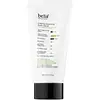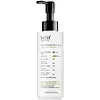What's inside
What's inside
 Key Ingredients
Key Ingredients

 Benefits
Benefits

 Concerns
Concerns

 Ingredients Side-by-side
Ingredients Side-by-side

Myristic Acid
CleansingWater
Skin ConditioningGlycerin
HumectantButylene Glycol
HumectantStearic Acid
CleansingPotassium Hydroxide
BufferingGlyceryl Stearate
EmollientPEG-100 Stearate
Sodium Methyl Cocoyl Taurate
CleansingPEG-40 Hydrogenated Castor Oil
EmulsifyingHydrogenated Polydecene
EmollientAvena Sativa Kernel Extract
AbrasiveCalendula Officinalis Flower Extract
MaskingNepeta Cataria Extract
TonicRubus Idaeus Leaf Extract
Skin ConditioningBaptisia Tinctoria Root Extract
Skin ConditioningStellaria Media Extract
Skin ConditioningSaponaria Officinalis Leaf Extract
AntimicrobialSapindus Mukorossi Fruit Extract
Skin ConditioningBenincasa Cerifera Seed Extract
Skin ConditioningAcorus Calamus Root Extract
PerfumingArtemisia Montana Leaf Powder
ExfoliatingTocopheryl Acetate
AntioxidantPolyquaternium-7
1,2-Hexanediol
Skin ConditioningTrisodium EDTA
Parfum
MaskingCitronellol
PerfumingLimonene
PerfumingMyristic Acid, Water, Glycerin, Butylene Glycol, Stearic Acid, Potassium Hydroxide, Glyceryl Stearate, PEG-100 Stearate, Sodium Methyl Cocoyl Taurate, PEG-40 Hydrogenated Castor Oil, Hydrogenated Polydecene, Avena Sativa Kernel Extract, Calendula Officinalis Flower Extract, Nepeta Cataria Extract, Rubus Idaeus Leaf Extract, Baptisia Tinctoria Root Extract, Stellaria Media Extract, Saponaria Officinalis Leaf Extract, Sapindus Mukorossi Fruit Extract, Benincasa Cerifera Seed Extract, Acorus Calamus Root Extract, Artemisia Montana Leaf Powder, Tocopheryl Acetate, Polyquaternium-7, 1,2-Hexanediol, Trisodium EDTA, Parfum, Citronellol, Limonene
Cetyl Ethylhexanoate
EmollientCaprylic/Capric Triglyceride
MaskingPEG-20 Glyceryl Triisostearate
EmollientTriethylhexanoin
MaskingDextrin Palmitate/Ethylhexanoate
EmulsifyingMacadamia Ternifolia Seed Oil
EmollientOlea Europaea Fruit Oil
MaskingAvena Sativa Kernel Extract
AbrasiveCalendula Officinalis Flower Extract
MaskingNepeta Cataria Extract
TonicRubus Idaeus Leaf Extract
Skin ConditioningBaptisia Tinctoria Root Extract
Skin ConditioningStellaria Media Extract
Skin ConditioningSaponaria Officinalis Leaf Extract
AntimicrobialSapindus Mukorossi Fruit Extract
Skin ConditioningBenincasa Cerifera Seed Extract
Skin ConditioningAcorus Calamus Root Extract
PerfumingTocopheryl Acetate
AntioxidantWater
Skin ConditioningParfum
MaskingCitronellol
PerfumingCetyl Ethylhexanoate, Caprylic/Capric Triglyceride, PEG-20 Glyceryl Triisostearate, Triethylhexanoin, Dextrin Palmitate/Ethylhexanoate, Macadamia Ternifolia Seed Oil, Olea Europaea Fruit Oil, Avena Sativa Kernel Extract, Calendula Officinalis Flower Extract, Nepeta Cataria Extract, Rubus Idaeus Leaf Extract, Baptisia Tinctoria Root Extract, Stellaria Media Extract, Saponaria Officinalis Leaf Extract, Sapindus Mukorossi Fruit Extract, Benincasa Cerifera Seed Extract, Acorus Calamus Root Extract, Tocopheryl Acetate, Water, Parfum, Citronellol
Ingredients Explained
These ingredients are found in both products.
Ingredients higher up in an ingredient list are typically present in a larger amount.
Acorus Calamus Root Extract is a fragrance.
Avena Sativa Kernel Extract is is derived from colloidal oatmeal. Besides being a healthy breakfast, oats have many benefits in skincare too.
This ingredient helps sooth, hydrate, and protect the skin. The starches in colloidal oatmeal are able to bind water, keeping the skin hydrated.
The cellulose and fiber in colloidal oatmeal help reduce inflammation. This can also help the skin feel softer.
Colloidal Oatmeal is also an antioxidant. Antioxidants protect our skin from free-radical damage.
Oatmeal also contains beneficial compounds:
This ingredient is created by mixing grounded oatmeal and a liquid base.
Learn more about Avena Sativa Kernel ExtractWe don't have a description for Baptisia Tinctoria Root Extract yet.
We don't have a description for Benincasa Cerifera Seed Extract yet.
Calendula Officinalis Flower Extract comes from the common Marigold plant. This ingredient is a skin conditioner.
Marigolds contain flavonoids. Flavonoids are a group of substances found naturally in plants. They possess antioxidant and inflammation properties.
This ingredient soothes skin inflammation by inhibiting inhibiting a part of the inflammation process.
Marigolds have been used in traditional medicine throughout Asia and Europe.
Learn more about Calendula Officinalis Flower ExtractCitronellol is used to add fragrance/parfum to a product. It is often derived from plants such as roses. In fact, it can be found in many essential oils including geranium, lavender, neroli, and more. The scent of Citronellol is often described as "fresh, grassy, and citrus-like".
Since the Citronellol molecule is already unstable, Citronellol becomes irritating on the skin when exposed to air.
Citronellol is a modified terpene. Terpenes are unsaturated hydrocarbons found in plants. They make up the primary part of essential oils.
Citronellol is not able to be absorbed into deeper layers of the skin. It has low permeability,
Citronellol is also a natural insect repellent.
Learn more about CitronellolCatnip has antioxidant and antimicrobial properties.
Fun fact: This plant is called "cataria" or "catnip" because 2/3 of all cats are attracted to this plant.
Parfum is a catch-all term for an ingredient or more that is used to give a scent to products.
Also called "fragrance", this ingredient can be a blend of hundreds of chemicals or plant oils. This means every product with "fragrance" or "parfum" in the ingredients list is a different mixture.
For instance, Habanolide is a proprietary trade name for a specific aroma chemical. When used as a fragrance ingredient in cosmetics, most aroma chemicals fall under the broad labeling category of “FRAGRANCE” or “PARFUM” according to EU and US regulations.
The term 'parfum' or 'fragrance' is not regulated in many countries. In many cases, it is up to the brand to define this term.
For instance, many brands choose to label themselves as "fragrance-free" because they are not using synthetic fragrances. However, their products may still contain ingredients such as essential oils that are considered a fragrance by INCI standards.
One example is Calendula flower extract. Calendula is an essential oil that still imparts a scent or 'fragrance'.
Depending on the blend, the ingredients in the mixture can cause allergies and sensitivities on the skin. Some ingredients that are known EU allergens include linalool and citronellol.
Parfum can also be used to mask or cover an unpleasant scent.
The bottom line is: not all fragrances/parfum/ingredients are created equally. If you are worried about fragrances, we recommend taking a closer look at an ingredient. And of course, we always recommend speaking with a professional.
Learn more about ParfumWe don't have a description for Rubus Idaeus Leaf Extract yet.
We don't have a description for Sapindus Mukorossi Fruit Extract yet.
We don't have a description for Saponaria Officinalis Leaf Extract yet.
We don't have a description for Stellaria Media Extract yet.
Tocopheryl Acetate is AKA Vitamin E. It is an antioxidant and protects your skin from free radicals. Free radicals damage the skin by breaking down collagen.
One study found using Tocopheryl Acetate with Vitamin C decreased the number of sunburned cells.
Tocopheryl Acetate is commonly found in both skincare and dietary supplements.
Learn more about Tocopheryl AcetateWater. It's the most common cosmetic ingredient of all. You'll usually see it at the top of ingredient lists, meaning that it makes up the largest part of the product.
So why is it so popular? Water most often acts as a solvent - this means that it helps dissolve other ingredients into the formulation.
You'll also recognize water as that liquid we all need to stay alive. If you see this, drink a glass of water. Stay hydrated!
Learn more about Water